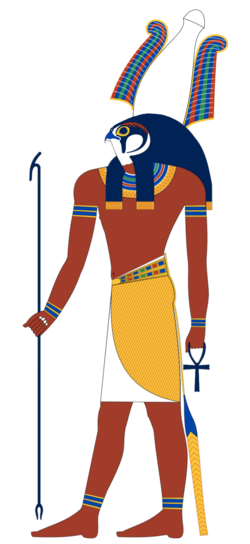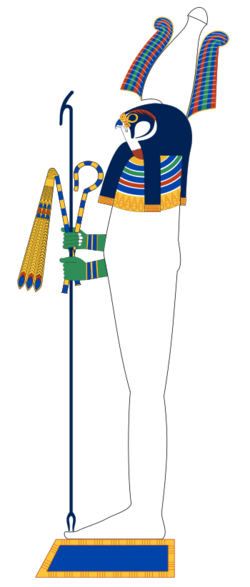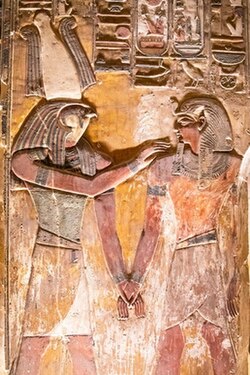Seker
Topic: Religion
 From HandWiki - Reading time: 5 min
From HandWiki - Reading time: 5 min
| Seker | |
|---|---|
 Seker was depicted as a falcon-headed man wearing an Atef crown | |
| Major cult center | Memphis |
Seker (/ˈsɛkər/; also spelled Sokar, and in Greek, Sokaris or Socharis) is a hawk or falcon god of the Memphite necropolis in the Ancient Egyptian religion, who was known as a patron of the living, as well as a god of the dead.[citation needed] He is also in some accounts a solar deity as for The Temple of Seker in Memphis.
Name
Although the meaning of his name remains uncertain, the Egyptians in the Pyramid Texts linked his name to the anguished cry of Osiris to Isis 'Sy-k-ri' ('hurry to me'),[1] or possibly skr, meaning "cleaning the mouth".[2] In the underworld, Seker is strongly linked with two other gods, Ptah the Creator god and chief god of Memphis, and Osiris the god of the dead. In later periods, this connection was expressed as the triple god Ptah-Seker-Osiris.[citation needed]
The Faiyumic Coptic form ⲥⲓⲭⲟⲗ is possibly preserved in a personal name ⲥⲉⲛⲥⲓⲭⲟⲗ, "daughter of Sokar".[3]
Appearance
Seker was usually depicted as a mummified hawk and sometimes as a mound from which the head of a hawk appears. Here he is called 'he who is on his sand'. Sometimes he is shown on his hennu barque which was an elaborate sledge for negotiating the sandy necropolis. One of his titles was 'He of Restau' which means the place of 'openings' or tomb entrances. Like many other gods, he was often depicted with a Was-scepter.[citation needed]
In the New Kingdom Book of the Underworld, the Amduat, he is shown standing on the back of a serpent between two spread wings; as an expression of freedom this suggests a connection with resurrection or perhaps a satisfactory transit of the underworld.[1] Despite this, the region of the underworld associated with Seker was seen as difficult, sandy terrain called the Imhet (also called Amhet, Ammahet, or Ammehet; meaning 'filled up').[4][5]
Roles and cults
Seker, possibly through his association with Ptah, has a connection with artisans. In the Book of the Dead, he is said to fashion silver bowls[1] and at Tanis a silver coffin of Sheshonq II has been discovered decorated with the iconography of Seker.[6]
Seker's cult centre was in Memphis, and festivals in his honor were held there on the 26th day of the fourth month of the akhet (spring) season. While these festivals took place, devotees would hoe and till the ground, and drive cattle, which suggests that Seker could have had agricultural aspects about him.[2]
Seker is mentioned in The Journey of Ra: the myth used to explain what happens during the night when Ra travels through the Underworld. According to the myth, Seker rules the Fifth Kingdom of Night,[7] which is called "Hidden",[7] and is tasked with punishing the souls of evildoers by throwing them into a boiling lake.[7]
As part of the festivals in akhet, his followers wore strings of onions around their necks, showing the Underworld aspect of him. Onions were used in embalming people - sometimes the skin, sometimes the entire onion. When just the skin was used, it would be placed on the eyes and inside the ears to mask the smell.[8]
Also, the god was depicted as assisting in various tasks such as digging ditches and canals. From the New Kingdom a similar festival was held in Thebes, which rivaled the great Opet Festival.[2][6]
Other events during the festival including floating a statue of the god on a Henu barque, which was a boat with a high prow shaped like an oryx.[9]
Popular culture
In the film The Ten Commandments (1956), the Pharaoh Rameses II invokes the same deity to bring his deceased firstborn son back to life, while wearing a dark blue robe with a silver bow.[citation needed]
In the show Stargate SG-1, the Goa'uld villain Sokar is named after Seker. Sokar appears as a powerful and sadistic Goa'uld who chose the role of the Devil rather than a god like the rest of his species. He is killed when the moon he uses as his own personal version of Hell is blown up, destroying Sokar's ship in orbit and Sokar himself.[citation needed]
American technical death metal band Nile wrote the title track of their album “Annihilation of the Wicked” about the domain, occupation, and appearance of Seker. Curiously, the lyrics seem to describe Seker in the form of Seker-Osiris, not Ptah-Seker-Osiris, deliberately excluding the aspects of Ptah. The lyrics call him "ancient and dead", a trait held by Osiris, but also describe him as being “shunned by Ra,” which would place the Seker they describe in the context of Heliopolis rather than Memphis.[citation needed]
The fantasy role playing game "Advanced Dungeons and Dragons" includes Seker in its 1st edition, "Deities and Demigods", and the "Legends and Lore" rulebooks. In this setting, Seker is described as the Egyptian lesser god of light and, among other details, he casts rays of light from his hands which destroy all undead. His Alignment is given as Neutral Good, and it is noted he protects Egyptian souls of the same Alignment after their death. No specific mention is made of the later triple persona, though his symbol is given as a hawk-headed mummy holding an ankh, which does at least indirectly suggest the connection.[10]
Gallery
Relief depicting Seker, Chapel of the High Priest of Ptah Sheshonq, twenty-second Dynasty, Cairo Museum
See also
- Sokar (Stargate)
References
- ↑ 1.0 1.1 1.2 The Routledge Dictionary of Egyptian Gods and Goddesses, George Hart ISBN:0-415-34495-6
- ↑ 2.0 2.1 2.2 "Sokar". http://www.ancientegyptonline.co.uk/sokar.html.
- ↑ Heuser, Gustav. Die Personennamen der Kopten. pp. 62.
- ↑ The Egyptian Amduat, Erik Hornung and Theodore Abt ISBN:3-9522608-4-3
- ↑ Budge, E.A. Wallis. An Egyptian Hieroglyphic Dictionary, vol. I. London, 1920.; pgs. 54-55.
- ↑ 6.0 6.1 The Complete Gods and Goddesses of Ancient Egypt, Wilkinson ISBN:0-500-05120-8
- ↑ 7.0 7.1 7.2 "Ancient Egyptian Legends: XI: The Regions of Night and Thick Darkness". https://www.sacred-texts.com/egy/ael/ael14.htm.
- ↑ Gahlin, Lucia (2014). Gods & Myths of Ancient Egypt. Southwater. pp. 46. ISBN 9781780193328.
- ↑ "sokar". http://www.ancientegyptonline.co.uk/sokar.html.
- ↑ Ward, James, with Rob Kuntz (1984). Legends and Lore. TSR Inc.. pp. 48. ISBN 0-935696-22-9.
Bibliography
- Graindorge, Catherine (1994). Le Dieu Sokar a Thebes Au Nouvel Empire (in French). Otto Harrassowitz Verlag. ISBN:3447034769.
- Mikhail, Louis B. (1984). "The Festival of Sokar: An Episode of the Osirian Khoiak Festival". Göttinger Miszellen 82.
External links
 |
 KSF
KSF




